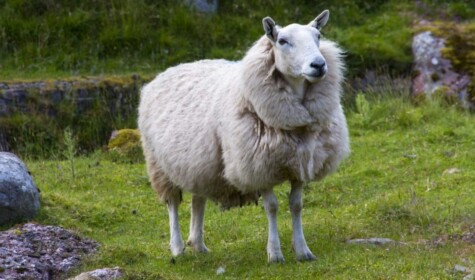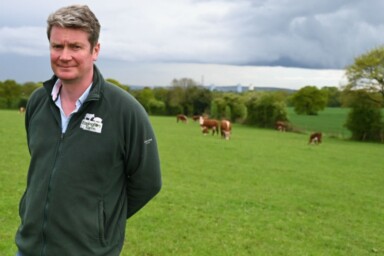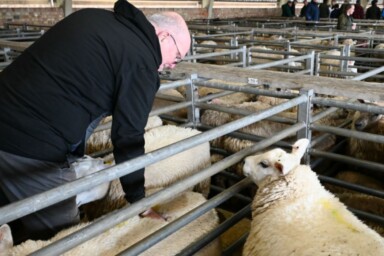Do you think you could taste a difference between a slice of roasted Welsh Mountain and a slice of Lleyn breed of mutton? As part of the Heritage Sheep feasibility study currently being carried out by the National Sheep Association (NSA), a taste test was carried out at the Welsh Winter Fair in November 2017. Show-goers were asked for their comments on eating differences between samples of mutton from three different Welsh breeds of sheep.
The NSA work is looking at a scheme to raise the public and market profile of non-standard sheep meat, which can be summarised as ABC:
- Different sheep Ages produce three products – lamb (up to one year old), hogget (1 to 2 years), and mutton (over two years old);
- the UK is alone in having over 60 British native Heritage Sheep Breeds (the most of any country);
- and the unique Countryside or landscape which produces them (often reflecting the feed available to the sheep).
Currently, most promotional work on sheep meat is focussed on one product, the Standard Lamb. However, like with most foodstuffs these days, there is in fact a wide diversity of sheep meat, but the public are not generally aware of it. We have become familiar in recent years of the variety of types of foods such as bread, beer, cheese or whisky – we now have more cheese varieties than the French – yet who but the most dedicated foodie will have heard of Suffolk breed salt marsh mutton from the Gower, or Swaledale hogget from the Yorkshire dales?
 This diversity of sheep meats offers much greater consumer choice than that which widely exists at present, and has the ability to create new markets, without diminishing the importance of the Standard Lamb product. In particular, examples such as gin, which is now the UK’s favourite spirit, has risen in popularity due to the engagement of so called Millennials, who enjoy trying different artisan varieties of gin. When sheep meat is considered, not only is overall consumption declining fairly rapidly, but the age profile of those still eating it is predominantly older. If the diversity of sheep meat could capture the imagination of the younger consumers, this would be a welcome boost for sheep producers, and would have a longer-term impact, assuming they continued to eat sheep meat as they became older.
This diversity of sheep meats offers much greater consumer choice than that which widely exists at present, and has the ability to create new markets, without diminishing the importance of the Standard Lamb product. In particular, examples such as gin, which is now the UK’s favourite spirit, has risen in popularity due to the engagement of so called Millennials, who enjoy trying different artisan varieties of gin. When sheep meat is considered, not only is overall consumption declining fairly rapidly, but the age profile of those still eating it is predominantly older. If the diversity of sheep meat could capture the imagination of the younger consumers, this would be a welcome boost for sheep producers, and would have a longer-term impact, assuming they continued to eat sheep meat as they became older.
The NSA see the potential for a more diverse sheep meat market much as the whisky sector. Like the sheep farmers’ Standard Lamb, whisky producers supply a standard mass-market product, blended grain. The difference is that in addition, whisky producers also have a wide range of malt whiskies. These vary according to the distillery location, ingredients and environment, and many people enjoy trying different labels, each with their own subtle differences in flavour and character, and categorised by terms such as ‘Light and Floral’, ‘Fruity and Spicy’, ‘Rich and Rounded’ or ‘Full-bodied and Smoky’. Just such a descriptive system could be applied to older sheep meat, perhaps using descriptors such as ‘Sweetness’, ‘Richness’, ‘Herby and Mildness’. However, before that, it needs to be demonstrated that there are indeed breed differences in eating qualities.
There is good scientific support for the influence of both age and landscape (in terms of the feed species it produces) on sheep meat flavour, but the only modern research on the impact of sheep breed on eating experience has been on lambs which, like veal compared to beef, have not yet fully developed particular breed characteristics of flavour and texture which can be found in the older hogget or mutton.
The Victorians, who were great enthusiasts for mutton believed that all the ABC factors affected the eating experience, and would talk passionately about their favourite age of animal, breeds and landscapes.
“The difference in the quality of the flesh of various breeds is a well-established fact, not alone in flavour, but also in tenderness.”
Mrs Beeton, 1864
“The quality of the mutton varies much in the different breeds. In the large, long-haired sheep it is coarse-grained, but disposed to be fat. In the smaller, and short woolled breeds, the flesh is closest grained and highest flavoured;”
John Lawrence, 1809
“Do not treat all mutton in the same way. The mountain breeds never put on fat like the lowland mutton, and the spicy thyme and herb fodder of the hills makes them much the best mutton obtainable.”
Dorothy Hartley 1954
According to a writer in 1840, one of Princess Diana’s ancestors, Lord Spencer “… for mutton to be consumed for his table, keeps Welsh sheep two years in Althorp Park, and thus has meat of the finest flavour.” Fans of the Downland breeds also debated the various merits of the breeds, as one writer in 1913 observed of the Shropshire breed “Butchers commend the breed for its quality and flavour, and in comparing it with its rival, the Southdown, contend that while quality is equal, the Shropshire has the advantage in the heavier weights attained.” The discussion was endless.
 In the past year, at least three meetings have been held in London, Edinburgh and Abergavenny, where different mutton breeds have been compared. Anecdotally, all three have shown significant differences in eating experience between the breeds. In London, a meeting of the Guild of Food Writers offered its members the opportunity to sample several different mutton breeds. There were gasps of surprise and joy at the variations between the breeds.
In the past year, at least three meetings have been held in London, Edinburgh and Abergavenny, where different mutton breeds have been compared. Anecdotally, all three have shown significant differences in eating experience between the breeds. In London, a meeting of the Guild of Food Writers offered its members the opportunity to sample several different mutton breeds. There were gasps of surprise and joy at the variations between the breeds.
However, until the NSA tasting at the Winter Fair, there had not been a systematic tasting of different mutton breeds, with an analysis of the various attributes of the meats.
Procedure
It was important for the NSA trial that as many variables as possible should be eliminated, other than the breed, and so care was taken to achieve that as closely as possible.
The animals
Three Welsh breeds were selected – South Wales Mountain, Beulah Mule and Lleyn, representing mountain, hill and lowland breeds. As far as possible, all three had been reared in a similar manner, all being grass-fed, the ages at slaughter differed slightly, from 3 to 7 years, and all carcases were dry-aged for 2–2.5 weeks.

The cooking and preparation
Two legs were selected for each breed, to be sampled across the two days of the Winter Fair. All legs were delivered to the cook, Lavinia Vaughan in Montgomeryshire, in insulated boxes with ice, a few days prior to cooking. One leg of each breed was cooked slowly overnight, prior to sampling, in sealed roasting bags. On the day of the sampling, they were allowed to cool, and transported to Builth Wells. They were then carved into sample-sized pieces of about 3cm long prior to serving. Paper plates were marked in pen 1, 2 and 3, and each plate was given a sample piece of each leg, next to the appropriate identifying number.
The tastings
 NSA staff offered the samples to Fair visitors, trying to ensure a reasonably equal spread of gender and age of samplers, recording both as they carried out the interviews.
NSA staff offered the samples to Fair visitors, trying to ensure a reasonably equal spread of gender and age of samplers, recording both as they carried out the interviews.
As the visitors tasted each sample, the NSA staff member asked them questions about that sample. They were asked to score various attributes as they ate them. These were:
Tenderness – 1 to 7. 1= tough, 7= very tender
Juiciness – 1 -7. 1 = dry, 7 = very juicy in the mouth
Sweetness – 1-7. 1= no sweetness, 7 = very sweet.
Then, also on a scale of 1 to 7, the samplers were asked to consider the extremes of flavour and texture between the samples and score on the differences between the three samples. Here, 1 would denote that they tasted no difference between the sample through to 7 which would denote a very great deal of difference.
The respondents were also asked about two further characteristics of the samples. These were the degree of ‘sheepiness’ in the flavour, and the ‘fattiness’ or ‘greasiness’ of the meats. Due to a misunderstanding amongst those recording the reactions, the results could not be used, but the vast majority thought that neither attribute was a problem in any of the samples.
The results
Over the two days of the tastings, 99 people were interviewed face to face on the samples.
Ages of participants
There was a generally good spread of ages.

Gender of Participants
Although there was a majority of men interviewed, it was only on a ratio of 55%:45%.

Scores on breed tastings
Below are graphs showing the frequency of scores given for each breed when tasters were asked about tenderness, juiciness and sweetness of each sample.



There was a good degree of difference between the breeds on ‘tenderness’, ‘juiciness’ and ‘sweetness’ scores across the breeds. The overall consensus was that all the breeds had high levels of all three attributes.
The degree of difference in eating quality between the three breeds
The purpose of this exercise was not to rank the breeds as one being better than another, but to gauge the degree of differences between the breeds.
This is demonstrated on the graph below, which shows that the majority of respondents thought there were significant differences between the breeds, with many saying that the differences were extremely large. This finding is in line with anecdotal results from the tastings carried out elsewhere.

Comparison of breeds

Whilst the NSA tasting exercise was not aimed at ranking the breeds, the results were particularly interesting in a couple of regards.
Firstly, the opening lines of the poem The War-song of Dinas Vawr by Thomas Love Peacock (1785-1866) are:
The mountain sheep are sweeter,
But the valley sheep are fatter;
We therefore deemed it meeter
To carry off the latter.
Throughout the Victorian period, UK mountain breeds of sheep were highly praised particularly for their sweetness, as per Peacock’s poem. The analysis of the NSA tastings clearly demonstrates the strong favourite for sweetness was the South Wales Mountain. Indeed, the mountain breed also scored the highest for tenderness.
The graph of differences between the breeds on flavour and texture above also shows significant differences between the breeds, sufficient to say that it should be possible to categorise breeds by taste traits, just as are malt whisky varieties.
This has significant implications for older sheep meat marketing, as it demonstrates that breed differences in older sheep are real. Further than that, it corroborates the views of Victorian writers that some breeds excel in certain attributes. Surely the Victorians would not have been surprised.
Photograph: Angel Ganev







